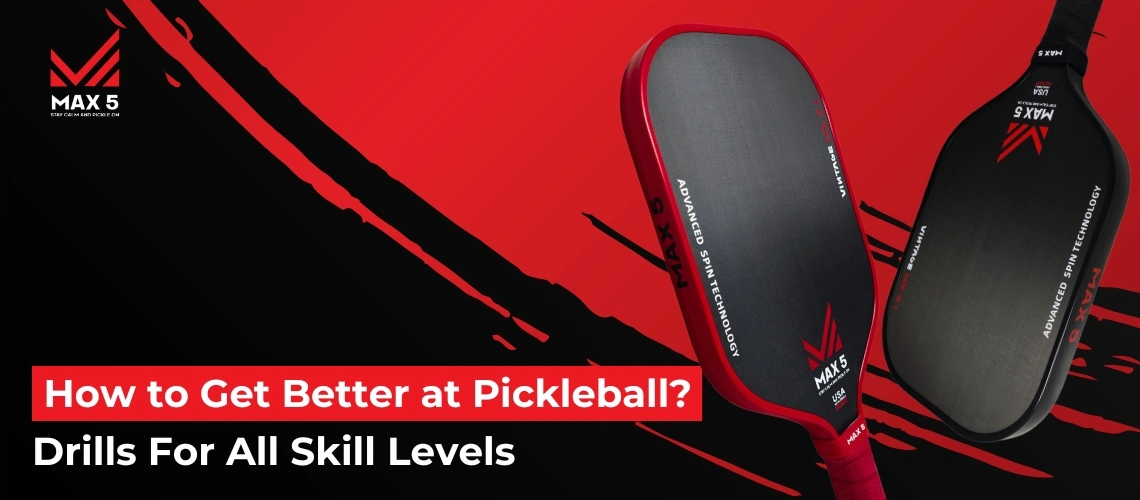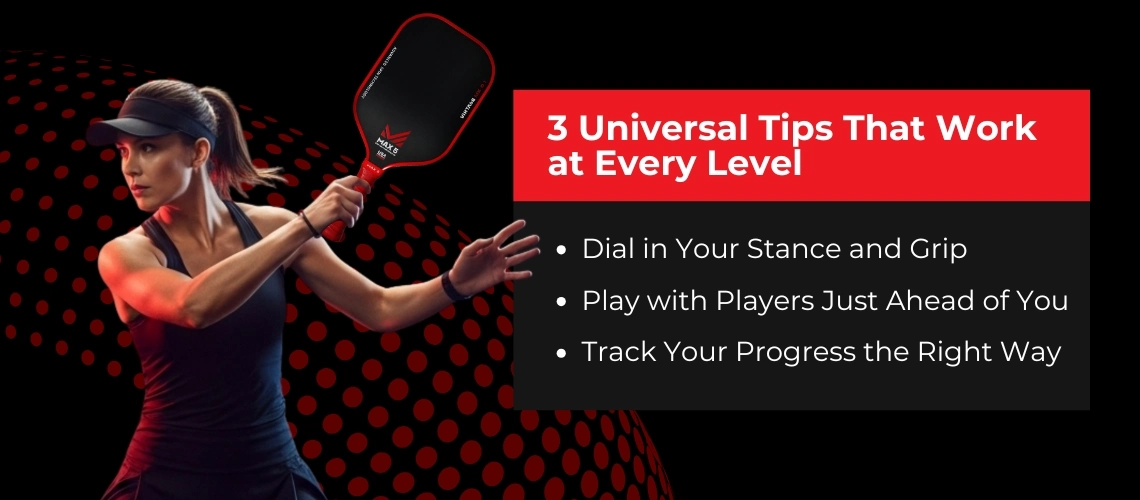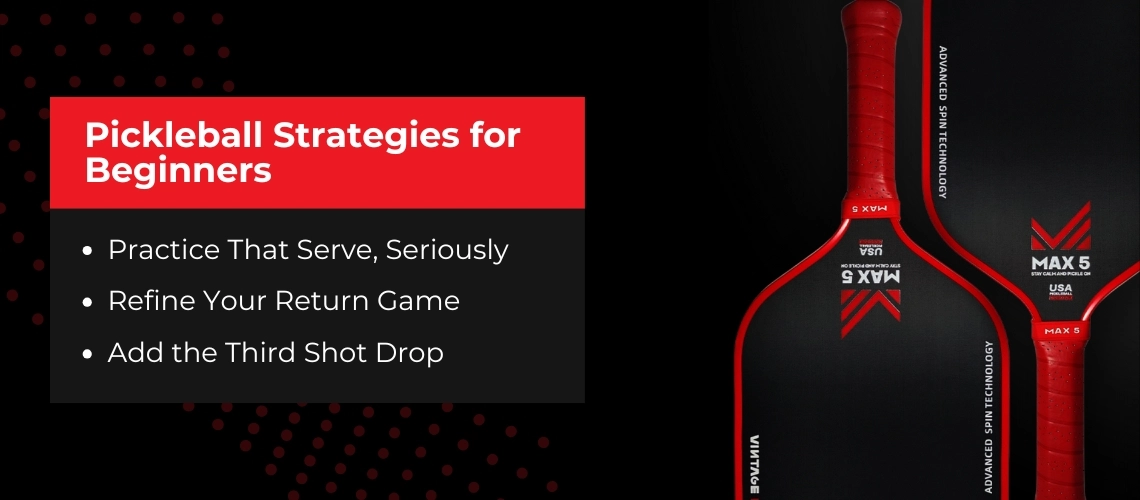
How to Get Better at Pickleball? Drills For All Skill Levels
About 19.8 million people have been playing pickleball in the US in 2025. Many parking lots, driveways, parks, recreational centers, and tournaments are seeing the rise of this blended sport of tennis, badminton, and ping-pong. But if you’ve picked up a paddle recently and thought, “I know how to play, but how do I get better?”, you’re not alone.
Let’s start with this: success in pickleball isn’t about brute force. It’s about anticipation, shot placement, and knowing how to stay one step ahead. A player who reads the game well will outlast a stronger hitter every time.
In this article, we’ll cover how to get better at pickleball or refine your game to compete at higher levels. This guide walks you through court-tested strategies, broken down by skill level and built around drills that work.
Universal Tips That Work at Every Level
From 2.0 beginners to 4.5 experts, these pickleball tips are effective for any skill set. They’re foundational, and smart players keep coming back to them.
1. Dial in Your Stance and Grip
Movement starts at your base. The right stance lets you stay agile without burning extra energy. Keep knees slightly bent, weight on the balls of your feet, and your paddle up, always ready.
Now the grip: Start with the continental grip, imagine shaking hands with your Max5 or any brand’s paddle. It gives you versatility for both forehands and backhands, especially during quick volleys. Prefer extra pop on forehands? Experiment with the eastern grip.
Pro tip!
Max5 paddles are engineered to match a beginner’s grip without losing the edge of performance. Max5’s carbon surface and balanced weight make the grip feel intuitive. You’ll feel the difference on net exchanges where timing and paddle angle matter most.
2. Play with Players Just Ahead of You
Want to improve fast? Play against someone slightly better. But not way better. If your opponent’s footwork, drops, and resets leave you clueless, it’s hard to learn anything from the beating. But if they challenge you just enough, every rally teaches you something.
- For context: USA Pickleball ratings range from 1.0 to 5.5+. New players should stick around 2.0-2.5 opponents. Systems like DUPR (2.000–8.000 scale) offer dynamic tracking, worth exploring if you’re serious about progress.
Stay Loose But Always Ready
Pickleball isn’t a game for daydreaming. If you’re flat-footed at the moment your opponent fires a serve, the point’s already gone. That doesn’t mean tensing up, you need an athletic stance, paddle up, and knees bent without overdoing it.
The goal is relaxed readiness. Paddle up. Shoulders aligned. React fast, but don’t freeze up.
3. Track Your Progress the Right Way
Improvement needs measurement. Use USA Pickleball’s printable skill sheets, from 2.0 to 5.0, and start checking off each skill as you master it. You can also log your wins/losses in DUPR or get feedback from a trusted partner. Better yet, record your matches and rewatch (cringe) and adjust by learning your flaws.
Pro tip!
Start attacking the backhand. Most players favour the forehand. Force them into uncomfortable shots, and you’ll create your chances. If your carbon paddle is rough and you do not know, do not worry, here is by step-by-step guide to cleaning a pickleball paddle with the help of a Max5 eraser.
Pickleball Strategies for Beginners (Foundation Level Tips)
Learning how to become a better pickleball player isn’t about flashy shots. It’s about doing the basics well. Once you have a grip on the core skills, stance, grip, and shot consistency, everything else builds from there.
1. Practice That Serve, Seriously!
You don’t need a partner to work on serves. Grab your Max5 paddle, head to a wall, and tape a line at 34-36 inches. Start with forehand and backhand volleys, center the ball, feel the paddle’s sweet spot, and keep a consistent rhythm.
Then move to your actual serve. Mix up placement and depth. One serve should drive deep; another should touch the sideline. Think less about raw power and more about control. Hitting your target consistently is a weapon. Once you can land the ball where you want, start adding variety, spin, depth, and pace.
2. Refine Your Return Game
A strong return is a tone-setter. The goal? Push your opponent back, forcing a weak third shot and setting you up for net control. Stand balanced. Keep your paddle up. Watch the server’s stance and backswing; those hints help you react faster. Then aim deep, ideally toward their backhand or sideline.
Max5 paddles are built with a larger sweet spot with 16mm thickness, and that’s gold here for beginners. Clean contact equals more controlled returns, the kind that pin your opponent behind the baseline.
3. Add the Third Shot Drop
The third shot drop is the beginner’s gateway to intermediate play. When returning a deep serve, instead of hitting a hard drive, try softly dropping the ball into the kitchen. It takes your opponent’s power away and gives you time to move in and gain net control.
Drill idea!
Outline your kitchen target areas using court tape. Aim for 8 out of 10 drops to land clean. Use a soft grip and an open paddle face. Max5’s carbon control surface helps reduce mis-hits here. The goal isn’t perfection. It’s confidence. You want to walk into every third shot knowing you can drop it clean more often than not.
Now You’re Intermediate, Expand Your Shot Arsenal
If you’ve moved past just surviving on the court, it’s time to learn how to improve your pickleball game and build a real tactical advantage. This means learning more shots, sharper footwork, and reading the game better than your opponent.
1. Dink With Purpose
The dink isn’t a stall; it can be used strategically, and many pros use it. Instead of blasting the ball, you’re making it go just over the net, into the kitchen. This forces your opponent to hit up, opening windows for attack. Focus on placement over power.
Use the Slinky Drill pickleball technique. Start at the net, dink a few, take a step back, repeat. This builds consistency while simulating match pressure.
Dinking well means:
- Targeting tricky spots (opponent’s backhand, sideline edges)
- Controlling pace
- Staying patient during long rallies
- Keeping the paddle up, always ready to volley
2. Master a Range of Shots
A predictable player is an easy target.
- Drive: Use when you get a high return. A flat, powerful shot keeps your opponent on the defensive. Make sure you’re balanced, and don’t overhit.
- Lob: Use it sparingly, but it’s great when your opponent crowds the net. Make sure it lands deep and high.
- Volley: When your opponent hits soft or slow, meet the ball before it bounces. Quick hands, short swing, eyes on the ball.
Mixing shots doesn’t just look good; it breaks the rhythm of your opponent. That alone wins points.
3. Improve Your Footwork
No skill matters more at the intermediate level than footwork. It’s not just about swinging, it’s also about positioning. Good footwork gives you more shot options and reduces unforced errors. Stand with feet shoulder-width apart, knees bent, and paddle up.
Use drills like:
- Side-to-side kitchen movement
- Quick backwards steps after dinks
- Net charges post-return
Advanced Techniques for Serious Players
At the highest level, you don’t have to play with power; you need to play with strategy. It’s about hitting high-percentage shots and staying calm under pressure. That means avoiding anything you can’t land 8 out of 10 times. Most match-losing errors come from overreaching for “hero shots” instead of reliable ones you’ve drilled hundreds of times.
Even professional players avoid low-probability shots in competition. A 3.0 player who focuses on smart shot selection and patient strategy will often outplay a more aggressive 3.5 opponent.
1. Stay Patient, Win the Rally
The best rallies aren’t rushed, they’re earned. Points can last a while, and players who stay composed typically come out ahead. Being patient means staying focused, resetting when needed, and forcing your opponent to make the first mistake. Your role is to keep placing the ball with intention until you see a real opportunity.
2. Move to Deep Serves and Power Placement
Once your serve is consistent, start pushing depth. Deep serves can push your opponent off the baseline, giving you the upper hand in the rally. Mix it up, aim toward their backhand, shift pace, or throw in angled volleys to keep them guessing. Adding deception (like faking a drive but dropping it short) is key as you climb levels. Study how Zane Navratil uses spin on the chainsaw serve, then drill it in slow motion.
3. Learn to Control Spin
Adding spin is strategic. Topspin dips fast, forcing rushed returns. Backspin floats and keeps shots low. Use a light brushing motion with a quality paddle like the MAX5 Vintage MX-0.1, which has a textured carbon face perfect for generating natural spin. Learning spin control makes your shots unpredictable, and that’s how you get good at pickleball.
Doubles Done Right: How to Be a Better Pickleball Teammate
Lastly, success in doubles isn’t just about skill, it’s about synergy. When both players are in sync, covering the court becomes second nature. If you’re wondering how to be a better pickleball teammate, start with these:
1. Communicate Everything
Before the first serve, talk. Decide who takes middle balls, how you’ll handle lobs, and what your signals will be. During the game, keep talking, “mine,” “yours,” “switch.” This prevents collisions and missed shots. A quick heads-up about where you’re placing your return can help your partner anticipate and adjust for the next shot.
Cheering for your teammate matters too. Encouragement builds rhythm, confidence, and chemistry. Doubles isn’t two singles players sharing a court, it’s one coordinated unit.
2. Drill Together A Lot
Improving your doubles game doesn’t happen just by playing matches. Top players drill more than they scrimmage. Reps matter. Spend time working on 3rd shot drops, dinks, resets, and serve returns with purpose. Make drilling competitive, track scores, set goals, and simulate match pressure.
Pro Tip!
One effective setup is the I-Formation: one player stays up while the other covers deep. It forces communication and quick decision-making. Nail your pre-serve cues and switching strategies, and you’ll start dictating play instead of reacting.
3. Hit With Purpose
Every shot should have a target and a reason. Think: What’s my best option here? Am I moving the opponent? Am I targeting their backhand? Playing smart means playing proactively. Instead of reacting, you’re orchestrating the rally.
Reading body language, anticipating movement, and placing the ball with intention are what separates strong teams from shaky ones. At higher levels, it’s not about power—it’s about precision and planning. Hit smart, not just hard.
Lasting Growth: Keep Practicing, Keep Learning
The truth about how to improve at pickleball? It never ends. You don’t graduate from fundamentals, you just get better at applying them under pressure. The pros drill footwork, resets, and dinks more than they play points. So should you.
Set performance targets, like landing 70% of your 3rd shot drops in each session. Warm up properly, stretch, and work on movement as much as mechanics. Train footwork with agility ladders, add lateral drills, and build endurance through short intervals. It’s more about being fit enough to make them when it matters.
The best investment you can make is a paddle that grows with you. The MAX5 Vintage MX 0.1 is made for developing players who want control, spin, and comfort, without spending a fortune. Its raw carbon fiber face and soft polypropylene core give you the right tools to practice dinks, spin serves, and resets with confidence.
Need more pop? Go heavier. Prefer control? Stick with mid-weight. Whatever your preference, Max5 paddles are balanced to help you level up.
Frequently Asked Questions
What is the Golden Rule of Pickleball?
Play with respect. Call lines honestly, support your partner, and don’t take things too seriously. A good match feels fair, even if it’s competitive.
What are the 3 Ways to Fault in Pickleball?
- Serving wide or into the net
- Stepping on or over the baseline when serving
- Volleying from the kitchen or landing in it mid-shot
What are Signs You’re a Bad Teammate?
- Teammates underperform with you
- You start negative or blame before the game begins
- Constantly criticize or blame partners mid-match
How Often Should I Practice to Get Better?
Drill 2-3 times a week minimum. It’s not about court time—it’s about focused reps that build habits and sharpen execution.
What Mistakes Do Beginners Make?
Standing flat-footed, hitting too hard, and poor shot selection. Start with footwork, soft hands, and positioning.
How Can I Stay Mentally Strong During Matches?
Play one point at a time. Breathe. Don’t overthink. Stay focused on your role, not the score.
What’s the Best Way to Improve Quickly?
Drill with intention. Record games. Watch better players. Use a paddle that gives you control, like the MAX5 MX 0.1 and commit to small progress.


